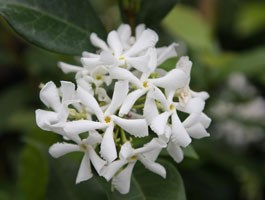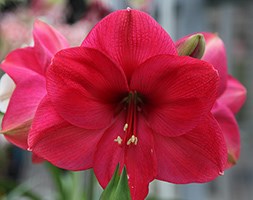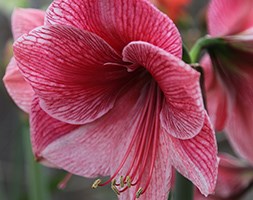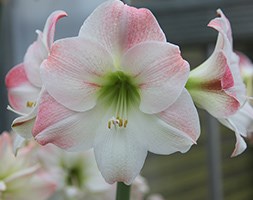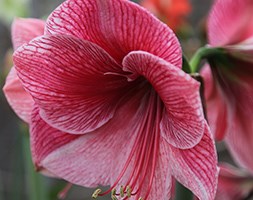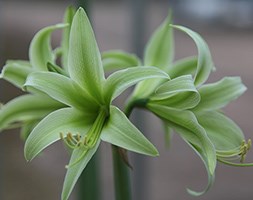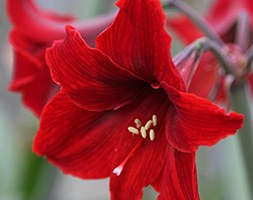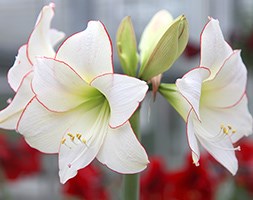New products at Crocus
by Sarah - March 18th, 2015.Filed under: Crocus, New Products.
New items today at Crocus
Trachelospermum jasminoides (star jasmine) £49.99
Position: full sun Soil: fertile, well-drained soil Rate of growth: average Flowering period: June to August Flower colour: white flowers Other features: very fragrant flowers Hardiness: frost hardy (needs winter protection) An attractive woody, evergreen climber with rich, dark green leaves which turn bronze in winter. Clusters of fragrant, pure white flowers are produced from mid- to late summer. It is best grown against a warm, sunny wall in milder areas or in a greenhouse or conservatory in areas prone to severe frosts. Garden care: After flowering has finished prune back to fit the available space. In frost prone areas, grow in pots of loam-based potting compost, such as John Innes No2 and move to a frost-free spot in winter.
Hippeastrum ‘Lagoon’ (amaryllis bulb) £8.99
Position: bright but not in full sun Soil: good quality potting compost Flowering period: December to March Hardiness: frost tender (will need winter protection) Bulb size: 26/28 General care: Fill a pot with good quality potting compost, setting the bulb in the compost so that the top two thirds are exposed. Water the compost only when the surface is dry, watering too much just after potting can cause the bulb to rot. Keep the plant in a sunny spot, though not direct sun and rotate the plant so as to avoid the flower stalk leaning towards the light. Once flowering has finished cut off the flower stalk 5-10cm above the bulb – don’t cut off the foliage. Water when the surface of the compost is dry and feed regularly with a balanced liquid fertiliser. Usually the best thing to do is keep watering it through the summer and in autumn stop watering and move to a dark, dim spot. This stimulates the drought season of the plant’s native South America. Allow it to dry out for a few months so that the foliage wilts and dies back. In November bring it back in to the light and start watering again. Old foliage should be removed though take care not to cut any new shoots off. In a few weeks a new flower shoot will appear and flower just in time for Christmas.
Hippeastrum ‘Purple Rain’ (amaryllis bulb) £8.99
Position: bright but not in full sun Soil: good quality potting compost Flowering period: December to March Hardiness: frost tender (will need winter protection) Bulb size: 26/28 General care: Fill a pot with good quality potting compost, setting the bulb in the compost so that the top two thirds are exposed. Water the compost only when the surface is dry, watering too much just after potting can cause the bulb to rot. Keep the plant in a sunny spot, though not direct sun and rotate the plant so as to avoid the flower stalk leaning towards the light. Once flowering has finished cut off the flower stalk 5-10cm above the bulb – don’t cut off the foliage. Water when the surface of the compost is dry and feed regularly with a balanced liquid fertiliser. Usually the best thing to do is keep watering it through the summer and in autumn stop watering and move to a dark, dim spot. This stimulates the drought season of the plant’s native South America. Allow it to dry out for a few months so that the foliage wilts and dies back. In November bring it back in to the light and start watering again. Old foliage should be removed though take care not to cut any new shoots off. In a few weeks a new flower shoot will appear and flower just in time for Christmas.
Hippeastrum ‘Apple Blossom’ (amaryllis bulb) £8.99
Position: bright but not in full sun Soil: good quality potting compost Flowering period: December to March Hardiness: frost tender (will need winter protection) Bulb size: 26/28 General care: Fill a pot with good quality potting compost, setting the bulb in the compost so that the top two thirds are exposed. Water the compost only when the surface is dry, watering too much just after potting can cause the bulb to rot. Keep the plant in a sunny spot, though not direct sun and rotate the plant so as to avoid the flower stalk leaning towards the light. Once flowering has finished cut off the flower stalk 5-10cm above the bulb – don’t cut off the foliage. Water when the surface of the compost is dry and feed regularly with a balanced liquid fertiliser. Usually the best thing to do is keep watering it through the summer and in autumn stop watering and move to a dark, dim spot. This stimulates the drought season of the plant’s native South America. Allow it to dry out for a few months so that the foliage wilts and dies back. In November bring it back in to the light and start watering again. Old foliage should be removed though take care not to cut any new shoots off. In a few weeks a new flower shoot will appear and flower just in time for Christmas.
Hippeastrum ‘Tosca’ (amaryllis bulb) £8.99
Position: bright but not in full sun Soil: good quality potting compost Flowering period: December to March Hardiness: frost tender (will need winter protection) Bulb size: 26/28 General care: Fill a pot with good quality potting compost, setting the bulb in the compost so that the top two thirds are exposed. Water the compost only when the surface is dry, watering too much just after potting can cause the bulb to rot. Keep the plant in a sunny spot, though not direct sun and rotate the plant so as to avoid the flower stalk leaning towards the light. Once flowering has finished cut off the flower stalk 5-10cm above the bulb – don’t cut off the foliage. Water when the surface of the compost is dry and feed regularly with a balanced liquid fertiliser. Usually the best thing to do is keep watering it through the summer and in autumn stop watering and move to a dark, dim spot. This stimulates the drought season of the plant’s native South America. Allow it to dry out for a few months so that the foliage wilts and dies back. In November bring it back in to the light and start watering again. Old foliage should be removed though take care not to cut any new shoots off. In a few weeks a new flower shoot will appear and flower just in time for Christmas.
Hippeastrum ‘Evergreen’ (amaryllis bulb) £8.99
Position: bright but not in full sun Soil: good quality potting compost Flowering period: December to March Hardiness: frost tender (will need winter protection) Bulb size: 26/28 General care: Fill a pot with good quality potting compost, setting the bulb in the compost so that the top two thirds are exposed. Water the compost only when the surface is dry, watering too much just after potting can cause the bulb to rot. Keep the plant in a sunny spot, though not direct sun and rotate the plant so as to avoid the flower stalk leaning towards the light. Once flowering has finished cut off the flower stalk 5-10cm above the bulb – don’t cut off the foliage. Water when the surface of the compost is dry and feed regularly with a balanced liquid fertiliser. Usually the best thing to do is keep watering it through the summer and in autumn stop watering and move to a dark, dim spot. This stimulates the drought season of the plant’s native South America. Allow it to dry out for a few months so that the foliage wilts and dies back. In November bring it back in to the light and start watering again. Old foliage should be removed though take care not to cut any new shoots off. In a few weeks a new flower shoot will appear and flower just in time for Christmas.
Hippeastrum ‘Gracilis’ (amaryllis bulb) £8.99
Position: bright but not in full sun Soil: good quality potting compost Flowering period: December to March Hardiness: frost tender (will need winter protection) Bulb size: 26/28 General care: Fill a pot with good quality potting compost, setting the bulb in the compost so that the top two thirds are exposed. Water the compost only when the surface is dry, watering too much just after potting can cause the bulb to rot. Keep the plant in a sunny spot, though not direct sun and rotate the plant so as to avoid the flower stalk leaning towards the light. Once flowering has finished cut off the flower stalk 5-10cm above the bulb – don’t cut off the foliage. Water when the surface of the compost is dry and feed regularly with a balanced liquid fertiliser. Usually the best thing to do is keep watering it through the summer and in autumn stop watering and move to a dark, dim spot. This stimulates the drought season of the plant’s native South America. Allow it to dry out for a few months so that the foliage wilts and dies back. In November bring it back in to the light and start watering again. Old foliage should be removed though take care not to cut any new shoots off. In a few weeks a new flower shoot will appear and flower just in time for Christmas.
Hippeastrum ‘Picotee’ (amaryllis Picotee) £7.99
Position: bright but not in full sun Soil: good quality potting compost Flowering period: September to December Flower colour: white edged pink Other features: knock-out flowers Hardiness: frost tender The white petals of this beautiful amaryllis have a fine, pink edge, which looks as though it has been drawn on with lip-liner. A gorgeous variety that will look very elegant insode during winter. Bulb Size: 26/28 General care: Fill a pot with good quality potting compost, setting the bulb in the compost so that the top two thirds are exposed. Water the compost only when the surface is dry, watering too much just after potting can cause the bulb to rot. Keep the plant in a sunny spot, though not direct sun and rotate the plant so as to avoid the flower stalk leaning towards the light. Once flowering has finished cut off the flower stalk 5-10cm above the bulb – don’t cut off the foliage. Water when the surface of the compost is dry and feed regularly with a balanced liquid fertiliser. Usually the best thing to do is keep watering it through the summer and in autumn stop watering and move to a dark, dim spot. This stimulates the drought season of the plant’s native South America. Allow it to dry out for a few months so that the foliage wilts and dies back. In November bring it back in to the light and start watering again. Old foliage should be removed though take care not to cut any new shoots off. In a few weeks a new flower shoot will appear and flower just in time for Christmas.







